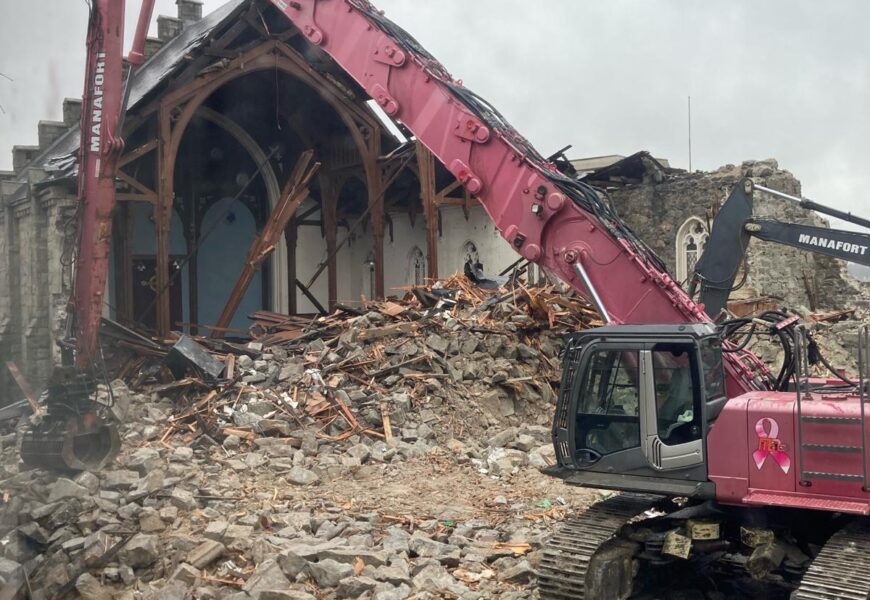Photo Courtesy of Elena Crowell ’25
On the afternoon of Thursday, Jan. 25, 2024, the steeple of the First Congressional Church collapsed, causing a stir in New London. Adjacent to the church is Connecticut College’s Manwaring building, an off-campus housing option for upperclassmen students in downtown New London. No students were injured during the collapse and only one person, the church office manager, was within the church at the time and exited with no apparent injuries.
As a result of the collapse, the city decided to tear down the entirety of the church due to too much damage done to the structure. Manwaring residents had to be moved during the demolition project. Dean of Students Victor Arcelus sent an email to Connecticut College students, faculty, and staff, stating, “The New London Fire Department notified Campus Safety and they immediately evacuated Manwaring. Campus Safety also sent a CCAlert to all students, notifying them that Manwaring needed to be evacuated and directing Manwaring residents to their email for more details. Manwaring students gathered in Cro’s Nest to meet with Office of Campus Life staff to check in and discuss the next steps.”
With a partnership that the College had established with the New London Holiday Inn during the COVID pandemic, Manwaring residents quickly moved into the Inn and met with the Red Cross to receive essential items until their return. On Tuesday, Jan. 30, 2024, once the initial phase of destruction was complete and the site was deemed safe, Manwaring residents moved back in. The demolition of the church was officially completed on Thursday, Feb. 1, 2024, and the land is currently being surveyed for an environmental assessment of the conditions of the grounds.
The First Congressional Church had been an iconic feature of New London since its founding by early town settlers in the 1600’s. Though the church is now destroyed, it had a history of accidents dating back to 1848, when the original church burned down in a fire. Following this incident, architect Leopold Eidlitz was commissioned to design a new church in the heart of New London. Eidlitz, originally from the Czech Republic, was well known for his architectural endeavors, specifically his work designing the New York State Capitol building and the “Iranistan,” a mansion built for P.T. Barnum in Bridgeport, Connecticut. In his creation of the First Congressional Church, he chose to design it in the Gothic Revival-style, a popular church design at the time commonly associated with the neoclassical revival throughout Britain and the United States. After just over a year of construction, the newest church was completed in June of 1853. Since the original construction of the church, changes had been added to the structure, including a bell tower and an additional building attached to the original church.
With its long history, the First Congressional Church of New London has had a profound impact on New London with its commitment to supporting the city and its people. Before its destruction, the church held breakfast on weekdays for community members of New London. Additionally, the church hosted funerals for homeless individuals in the New London community after their passing. Currently, church services have been moved to local churches across the New London area, including Hallam Chapel. In remembrance of the church, Studio 33 Art & Frame Gallery will present a new exhibit on Feb. 14, “A Church With Heart In The Heart Of The City,” celebrating the church’s impact on the community of New London and appreciating the space it provided for many.
Though the beloved New London skyline will never be the same, the collapse of the First Congressional Church has shown how our community continues to persist through the challenges it faces and emerges even stronger than before. Further, the legacy of the First Congressional Church lives on through the many people it has impacted and the connection New London Residents have with this historical monument.










Thanks for this overview. You might want to correct a typo that recurs in your article: should be “congregational” not “congressional”.
It’s really hard to substantiate any claim that the church is stronger than ever before. The collapse of the building was a massive failure, and demonstrates lack of attention to preservation and insufficient resources to full structural inspections and preventative maintenance.
If you are interested to do a follow up story, interviewing architects and engineers about the specific causes of the collapse, then your reporting would get a wider circulation. Many people want to learn more about that.